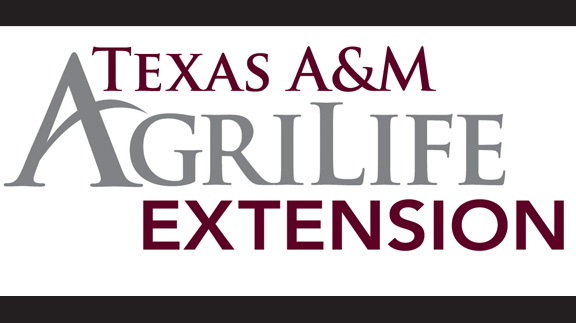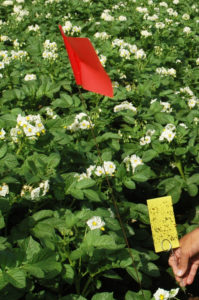Farm & Ranch
[AgriLife Today] Potato psyllid survey team aids producer treatment decisions in Texas

By: Kay Ledbetter
Writer: Kay Ledbetter, 806-677-5608, [email protected]
Contact: Dr. Charlie Rush, 806-354-5804, [email protected]
AMARILLO – Adult potato psyllids are testing positive in the Rio Grande Valley and Pearsall. That’s all potato growers need to know across Texas to start planning their attack.

Yellow sticky traps set up both inside potato fields and on the perimeters help trap potato psyllids for testing by Texas A&M AgriLife Research. (Texas A&M AgriLife photo by Kay Ledbetter)
Texas A&M AgriLife Research is at the forefront of the notification process in the battle against zebra chip of potato, a disease that once almost destroyed the potato industry in Texas. While the disease is not harmful to humans, the discoloration it causes results in discounts on potatoes going into the market.
For the past eight years, an AgriLife Research team devoted to tracking psyllid populations throughout the state has been doing its part to make the disease manageable and aid growers in decisions on the farm.
The Texas Psyllid Survey Team collects and tests psyllids from across the state beginning in late February and through late July when potato harvest wraps up in the High Plains. Weekly reports are sent out on Fridays.
The reports alert potato growers where adult psyllids are found and if they are positive for the bacterium Candidatus Liberibacter solanacearum, which causes zebra chip of potato.
The AgriLife Research team consists of Dr. Charlie Rush, plant pathologist; Li Paetzold, senior research associate; Dr. Fekede Workneh, senior research scientist, all in Amarillo; and Dr. Ismael Badillo, insect vector entomologist, and Adrian Silva, research associate, at Weslaco.
The battle against zebra chip began in South Texas in 2000 after the disease spread and caused significant economic losses in every potato production region in the state. By 2004-2005, zebra chip was responsible for millions of dollars in losses to South Texas producers and processors, and from 2006-2008, damage caused by the disease in West Texas and the High Plains was estimated at $33.4 million annually.
In 2009, the bacterium vectored by the potato psyllid and the cause of zebra chip was identified. Soon after this discovery and in direct response to requests for help from the Texas potato industry, the Texas Potato Psyllid Survey Team came into existence.
With financial support from the Texas Legislature’s Texas Zebra Chip Legislative Initiative and from the U.S. Department of Agriculture Specialty Crop Research Initiative, a statewide potato psyllid monitoring program was established, Rush said. The goal was to provide producers with information concerning the numbers of psyllids entering their fields during the growing season and the percentage of those psyllids positive for the bacterium.
To provide this data, psyllid populations are continuously monitored throughout the growing season in commercial potato fields in all four major potato production regions of the state, he said. At each commercial field, yellow sticky cards are set out weekly by the producer along the field from the southern edge inward to the center to trap psyllids.
Adult psyllids captured on the sticky traps are counted in Weslaco using a stereomicroscope and leaf samples are processed to determine counts of potato psyllid eggs, small nymphs and large nymphs, Rush said.
After the number of psyllids is recorded, they are shipped overnight to the AgriLife Plant Pathology Laboratory in Bushland to be tested for the bacterium.
Typically, potato psyllids recovered from the sticky traps are shipped to Rush’s lab each Wednesday during the growing season. Results for the bacterium are usually available within 24 hours after receipt of samples, and they are immediately sent to Badillo and Silva for distribution to producers by email.
The report goes to approximately 200 recipients, Rush said, including growers, crop consultants, potato processors, agri-industry representatives, federal and state scientists, Extension specialists and administrators.
The most immediate value of the weekly survey information is to growers who use it to discern whether or when to make insecticide applications and evaluate the efficacy of various chemistries on the different life stages of the psyllids, he said.
The data supplied through the survey provides growers with the information needed to make management decisions and gives them confidence they can continue profitable potato production even in the presence of zebra chip, Rush said.
This is verified by growers who said that instead of going out of business, as was feared in the early 2000’s, the Texas potato industry has significantly grown in the last five years.
Jack Wallace, a potato grower near Weslaco, said his farm has been affected by the devastating impact of the potato psyllid and its destructive pathogen over the past 16 years.
“The threat of the elimination of potato production, not only in our operation, but in Texas was real due to potato quality issues,” Wallace said. “The efforts of this survey team, as well as other collaborators of Texas A&M AgriLife, has substantially reduced this threat and potato production in the state has actually increased.”
Rush said the program also is instrumental in furthering basic scientific understanding of zebra chip, the bacterium and its psyllid vector. The survey data has been used in development of disease forecasting models and to answer questions concerning vector ecology and zebra chip epidemiology.
Additionally, psyllid colonies with and without the bacterium from the different collection locations have been established and are freely provided to other researchers in Texas and around the U.S., he said.
Specific uses of these colonies include studies on vector resistance to neonicotinoid insecticides, disease development as impacted by time of infection, and genetic-resistance screening for potato breeding programs, Rush said.
-30-
Find more stories, photos, videos and audio at http://today.agrilife.org
Farm & Ranch
Managing Show Cattle Through The Winter

By Heather Welper
Husband and wife duo, Heather and Calvin Welper, are the Co-Owners and Operators or Two C Livestock, located in Valley View, Texas.
The pair’s operation has a show cattle focus where they raise and sell purebred heifers of all breeds and club calf Hereford steers.
When it comes to show cattle, the Welpers know a thing or two including how to prepare for the cold winter months and the Texas major show season run.
To read more, pick up a copy of the November edition of North Texas Farm & Ranch magazine, available digitally and in print. To subscribe by mail, call 940-872-5922.

Farm & Ranch
Double M Ranch & Rescue

By Hannah Claxton, Editor
As the sun rises each day, so do the dozens of mouths that Meghan McGovern is responsible for getting fed. Rather than the sounds of a rooster crowing, McGovern hears the bellows and bleats of a variety of exotic deer, the chortle of kangaroos, the grunts of water buffaloes, and the chirps of a lemur.
Nestled against the banks of the Red River, the Double M Ranch and Rescue, with its high game fences and deer sprinkling the landscape,s its in stark contrast to the surrounding ranches.
“Having deer is kind of like eating potato chips- you can never actually have just one,” said McGovern with a laugh.
McGovern has several herds to take care of- fallow deer, axis deer, water buffalo, goats, and bison. In smaller numbers, there’s also a few kangaroos, a lemur, a potbelly pig, a pair of zebras, a watusi, and a few horses.
To read more, pick up a copy of the November edition of North Texas Farm & Ranch magazine, available digitally and in print. To subscribe by mail, call 940-872-5922.

Farm & Ranch
Acorn Toxicity

By Barry Whitworth, DVM, MPH
With the prolonged drought, most pastures in Oklahoma end up in poor condition. With the lack of available forage, animals may go in search of alternative foods.
If oak trees are in the pastures, acorns may be a favorite meal for some livestock in the fall. This may result in oak poisoning.
Oak leaves, twigs, buds, and acorns may be toxic to some animals when consumed.
To read more, pick up a copy of the November edition of North Texas Farm & Ranch magazine, available digitally and in print. To subscribe by mail, call 940-872-5922.

-

 Country Lifestyles2 years ago
Country Lifestyles2 years agoScott & Stacey Schumacher: A Growth Mindset
-

 Country Lifestyles8 years ago
Country Lifestyles8 years agoStyle Your Profile – What your style cowboy hat says about you and new trends in 2017
-

 HOME8 years ago
HOME8 years agoGrazing North Texas – Wilman Lovegrass
-

 Outdoor10 years ago
Outdoor10 years agoButtercup or Primrose?
-

 Country Lifestyles5 years ago
Country Lifestyles5 years agoAmber Crawford, Breakaway Roper
-

 Equine1 year ago
Equine1 year agoThe Will to Win
-

 Country Lifestyles9 years ago
Country Lifestyles9 years agoJune 2016 Profile – The man behind the mic: Bob Tallman
-

 Country Lifestyles8 years ago
Country Lifestyles8 years agoDecember 2016 Profile, Rusty Riddle – The Riddle Way




